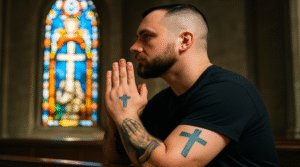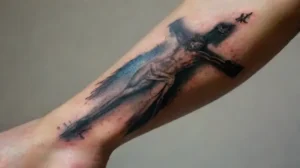Throughout history, many cultures and religions have used body art as a form of expression and spiritual connection. From ancient tribal markings to modern tattoos, these practices often serve to symbolize devotion, identity, or rites of passage. Understanding the theological implications of body art helps us explore how spirituality can be manifested through physical adornment.
In contemporary society, body art continues to evoke diverse interpretations. Some see tattoos and piercings as personal statements, while others perceive them as spiritual symbols. Delving into different faith traditions offers insight into how body modifications are evaluated within various spiritual frameworks.
Historical Significance of Body Art in Religious Cultures
Many ancient civilizations incorporated body art into their religious rituals. Egyptian mummies have markings suggesting beliefs about the afterlife, while Polynesian cultures used tattoos as a sign of social status and divine favor. These practices often aimed to honor deities or invoke spiritual protection.
Religious rites of passage frequently involve body modifications, symbolizing spiritual transformation. For example, initiation ceremonies in indigenous tribes may include scarification or tattooing to mark spiritual awakening. Such practices reinforce the connection between physicality and spiritual identity.
Throughout history, body art served as a visual language that expressed faith, allegiance, or divine presence. These markings often carried sacred meanings, serving as a bridge between the material and spiritual worlds. They reflected a society’s collective beliefs and spiritual values.
Theological Interpretations of Body Art
Different faith traditions offer varied perspectives on body art. In some religions, tattoos and piercings are considered sacred acts that enhance spiritual devotion. In others, they may be viewed as disrespectful or distracting from spiritual purity.
Christianity has diverse views; some denominations accept body art as a personal expression, while others see it as conflicting with biblical teachings on the body as a temple. The interpretation often depends on cultural contexts and individual beliefs about holiness and humility.
Islam generally discourages body modifications that alter the natural form, emphasizing modesty and respect for Allah’s creation. Conversely, certain Hindu practices incorporate body art into spiritual disciplines, seeing tattoos as symbols of spiritual journeys and divine protection.
In Buddhism, the focus is often on inner transformation rather than external adornment. However, some Buddhist cultures incorporate tattoos as sacred symbols or as part of monastic traditions, representing spiritual vows and commitments.
Body Art as a Form of Spiritual Expression

For many individuals, body art becomes a powerful means of expressing faith and spiritual identity. Tattoos bearing religious symbols—such as crosses, mandalas, or lotus flowers—serve as daily reminders of spiritual beliefs and commitments.
Such expressions can foster a sense of belonging to a spiritual community and reinforce one’s personal faith. They often act as external manifestations of internal convictions, bridging the internal and external worlds.
Moreover, body art can be a form of meditation or ritual, helping practitioners focus their spiritual intentions. By engraving sacred motifs on their bodies, individuals may seek divine blessings or spiritual protection.
Ethical Considerations and Body Art
The ethics of body art in a spiritual context can be complex. Some argue that piercing or tattooing the body for aesthetic reasons may conflict with spiritual principles of modesty or humility. Others believe that body modifications are a form of personal freedom and spiritual expression.
Cultural appropriation is another concern, especially when sacred symbols are used without understanding their true significance. Respect for the origins and meanings of spiritual body art is essential to honor the traditions and sentiments attached to these practices.
Many spiritual communities emphasize intentions behind body art. If the purpose aligns with personal faith or spiritual growth, it may be seen as a valid expression. However, superficial or commercial motives can diminish the spiritual significance of such practices.
Body Art and Spiritual Identity in Modern Society

In today’s world, body art often blurs the boundaries between personal identity and spiritual symbolism. People incorporate religious symbols into tattoos or piercings to express their faith publicly and authentically.
This integration reflects an evolving understanding of body art as a meaningful spiritual tool rather than mere decoration. Many see it as an empowering way to embody their beliefs and connect with their spiritual roots.
As society becomes more accepting of diverse expressions, the spiritual significance of body art continues to grow. It fosters dialogue about faith, identity, and the body’s sacred role in spiritual life.
Body Art in Contemporary Religious Practice
Certain religious groups now incorporate body art into their rituals to deepen spiritual engagement. For example, some Christian communities perform ceremonial tattoos as acts of commitment, similar to baptism.
Other faiths see body art as integral to meditative or prayer practices. Mandala tattoos in Hindu and Buddhist traditions, for instance, serve as visual aids to focus spiritual intentions and mindfulness.
In some cases, spiritual leaders endorse body art as a way to foster community identity and reinforce shared beliefs. These practices demonstrate how modern spirituality can embrace body modifications as sacred acts.
Conclusion
The relationship between body art and spirituality remains complex and deeply personal. While some traditions see tattoos and piercings as sacred symbols and expressions of faith, others view them through a critical lens rooted in biblical or doctrinal teachings. What remains universal is the idea that the body often serves as a canvas for spiritual meaning and identity.
Ultimately, whether considered a divine gift or a personal statement, body art continues to be a profound way for individuals to connect with their spirituality. As society’s perceptions evolve, so too does the understanding of body modifications as a reflection of a person’s faith, beliefs, and inner journey.







